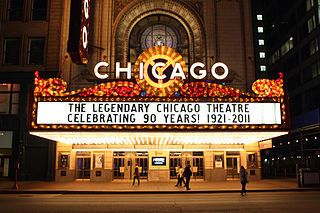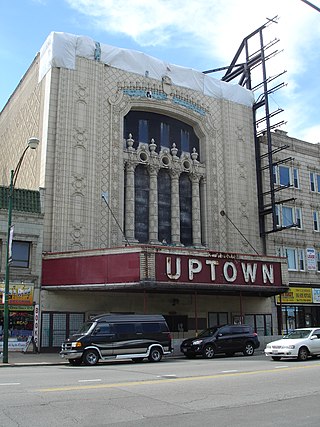
An off-Broadway theatre is any professional theatre venue in New York City with a seating capacity between 100 and 499, inclusive. These theatres are smaller than Broadway theatres, but larger than off-off-Broadway theatres, which seat fewer than 100.

Broadway theatre, or Broadway, is a theatre genre that consists of the theatrical performances presented in 41 professional theaters, each with 500 or more seats, in the Theater District and Lincoln Center along Broadway, in Midtown Manhattan, New York City. Broadway and London's West End together represent the highest commercial level of live theater in the English-speaking world.

Uptown is one of Chicago's 77 community areas. Uptown's boundaries are Foster Avenue to the north; Lake Michigan to the east; Montrose Avenue, and Irving Park Road to the south; Ravenswood Avenue, and Clark Street to the west. To the north is Edgewater, to the west is Lincoln Square, and to the south is Lakeview. Near the lake are some of the northern reaches of Lincoln Park, including Montrose Beach and multiple nature reserves. The area has a mix of commercial and residential development, and includes a well-established entertainment district of clubs and concert venues, and was a center for early film making. Truman College, a two-year city college, is located here, and the area's southwest corner includes the historic 19th century Graceland Cemetery.
The Second City is an improvisational comedy enterprise. It is the oldest improvisational theater troupe to be continuously based in Chicago, with training programs and live theatres in Toronto and Los Angeles. The Second City Theatre opened on December 16, 1959, and has become one of the most influential and prolific comedy theatres in the English-speaking world. In February 2021, ZMC, a private equity investment firm based in Manhattan, purchased the Second City.

Theater in Chicago describes not only theater performed in Chicago, Illinois, but also to the movement in Chicago that saw a number of small, meagerly funded companies grow to institutions of national and international significance. Chicago had long been a popular destination for touring productions, as well as original productions that transfer to Broadway and other cities. According to Variety editor Gordon Cox, beside New York City, Chicago has one of the most lively theater scenes in the United States. As many as 100 shows could be seen any given night from 200 companies as of 2018, some with national reputations and many in creative "storefront" theaters, demonstrating a vibrant theater scene "from the ground up". According to American Theatre magazine, Chicago's theater is "justly legendary".

The Chicago Theatre, originally known as the Balaban and Katz Chicago Theatre, is a landmark theater located on North State Street in the Loop area of Chicago, Illinois. Built in 1921, the Chicago Theatre was the flagship for the Balaban and Katz (B&K) group of theaters run by A. J. Balaban, his brother Barney Balaban and partner Sam Katz. Along with the other B&K theaters, from 1925 to 1945 the Chicago Theatre was a dominant movie theater enterprise. Currently, Madison Square Garden, Inc. owns and operates the Chicago Theatre as a 3600 seat performing arts venue for stage plays, magic shows, comedy, speeches, sporting events and popular music concerts.

The Lyric Theatre is a Broadway theater at 214 West 43rd Street in the Theater District of Midtown Manhattan in New York City. Opened in 1998, the theater was designed by Richard Lewis Blinder of Beyer Blinder Belle, in collaboration with Peter Kofman, for Garth Drabinsky and his company Livent. The Lyric Theatre was built using parts of two former theaters on the site: the Apollo Theatre, built in 1920 to a design by Eugene De Rosa, and the old Lyric Theatre, built in 1903 to a design by Victor Hugo Koehler. The theater contains 1,622 seats across three levels and is operated by Ambassador Theatre Group (ATG). The theater building is owned by the city and state governments of New York and was developed by New 42nd Street.

Uptown Theatre is a currently closed movie palace and concert venue located in the Uptown neighborhood of Chicago, Illinois. Designed by Rapp and Rapp and built by Paschen Bros. contractors, it is one of the many movie palaces built by the Balaban & Katz theatre chain run by A. J. Balaban, his brother Barney Balaban, and their partner Sam Katz.

The James M. Nederlander Theatre is a theater located at 24 West Randolph Street in the Loop area of downtown Chicago, Illinois. Previously known as the Oriental Theatre, it opened in 1926 as a deluxe movie palace and vaudeville venue. Today the Nederlander presents live Broadway theater and is operated by Broadway In Chicago, currently seating 2,253.

The Hippodrome Theatre, also called the New York Hippodrome, was a theater located on Sixth Avenue between West 43rd and West 44th Streets in the Theater District of Midtown Manhattan in New York City. The theater operated from 1905 to 1939 and was called the world's largest theater by its builders, with a seating capacity of 5,300 and a stage measuring 100 by 200 feet. It had state-of-the-art theatrical technology, including a rising glass water tank.

Balaban and Katz Theater Corporation, or B&K, was a theatre corporation which owned a chain of motion picture theaters in Chicago and surrounding areas.

The Howard Theatre is a historic theater, located at 620 T Street, Northwest, Washington, D.C. Opened in 1910, it was added to the National Register of Historic Places in 1974.

The Riviera Theatre is a concert venue located on the north side of Chicago, Illinois, United States.

The ten-story Fine Arts Building, formerly known as the Studebaker Building, is located at 410 S Michigan Avenue across from Grant Park in Chicago in the Chicago Landmark Historic Michigan Boulevard District. It was built for the Studebaker company in 1884–1885 by Solon Spencer Beman, and extensively remodeled in 1898, when Beman removed the building's eighth (top) story and added three new stories. Studebaker constructed the building as a carriage sales and service operation with manufacturing on upper floors. The two granite columns at the main entrance, 3 feet 8 inches (1.12 m) in diameter and 12 feet 10 inches (3.91 m) high, were said to be the largest polished monolithic shafts in the country. The interior features Art Nouveau motifs and murals by artists such as Martha Susan Baker, Frederic Clay Bartlett, Oliver Dennett Grover, Frank Xavier Leyendecker, and Bertha Sophia Menzler-Peyton dating from the 1898 renovation. In the early 20th century, the Kalo Shop and Wilro Shop, firms owned by women and specializing in Arts and Crafts items, were established in the Fine Arts Building.

The Copernicus Center is a 1,852-seat former movie palace that is now part of the Copernicus Center in the Jefferson Park community area of Chicago in Cook County, Illinois, United States. The Copernicus Center is located at 5216 W. Lawrence Avenue.

Located at Six Corners in the Portage Park neighborhood of Chicago's Northwest Side, the Portage Theater is one of the oldest movie houses in Chicago. The Portage Theater opened on December 11, 1920 as the Portage Park Theatre. Built for the Ascher Brothers circuit with 1,938 seats, the Portage was the first theater built specifically for film in the area.
Jason Brett is an American actor, writer and film producer, who produced the 1986 romantic comedy film About Last Night.
The United Artists Theatre was a popular movie theatre located in the Chicago Loop. It was built as a live venue called the Apollo, then later turned into a cinema. It was demolished in 1989.

New 42 is a not-for-profit organization based in Manhattan, New York City. In 1990, the New 42nd Street was formed to oversee the redevelopment of seven neglected and historic theatres on 42nd Street between Seventh and Eighth Avenues, and to restore the block to a desirable tourist destination in Manhattan. The theatres were the Apollo Theatre, the Empire Theatre, the Liberty Theatre, the Lyric Theatre, the Selwyn Theatre, the Times Square Theatre, and the Victory Theater.
The State of New York is a major center for all types of music. Its diverse community has contributed to introducing and spreading many genres of music, including salsa, jazz, folk, rock and roll, and classical. New York's plethora of music venues and event halls serve as popular markers which have housed many noteworthy artists.

















